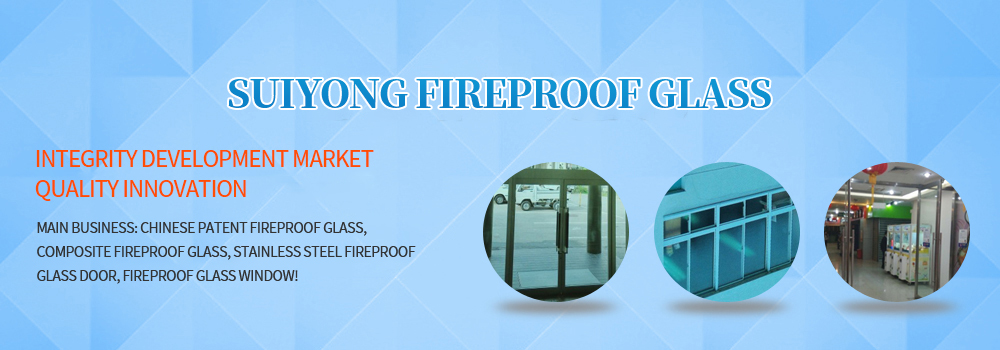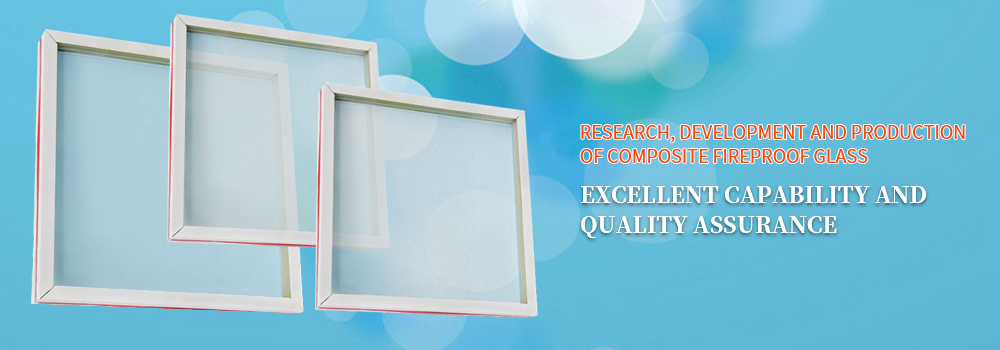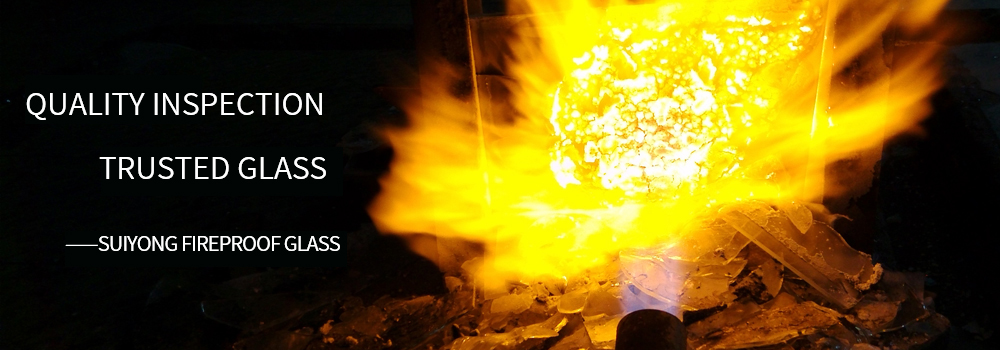 Welcome to Dongguan Suiyong Glass Technology Co., Ltd!
Welcome to Dongguan Suiyong Glass Technology Co., Ltd!Dongguan Suiyong fireproof glass technology Co., Ltd
Contact: Mr. Yu
Mobile: 136 0259 0190
Tel: 0755-27658310
Fax: 0755-27658310
EMAIL: 153478176@qq.com
Q Q:646193419
Address: plant 4, No. 28, Qisha Road, Qisha Industrial Zone, Shatian Town, Dongguan
- Structural division of fireproof glass
- Precautions for application of fireproof glass
- The types of laminated fireproof glass are introduced
- When winter comes, we need to know about fire prevention
- Composition and skill requirements of fire windows
- What are the common fireproof windows of fireproof glass?
- Glass fiber composite air duct integrates multiple functions
Surface treatment skills of fireproof glass for construction
1. Fireproof glass for construction is divided into composite fireproof glass (FFB) and single fireproof glass (DFB) according to structure.
Composite fireproof glass: it is a special glass composed of two or more layers of glass, or one layer of glass and organic materials, and meets the requirements of corresponding fire resistance rating. Monolithic fireproof glass: it is a special glass composed of single-layer glass and meets the corresponding fire resistance rating requirements.
According to the structural type, fireproof glass can be divided into: fireproof laminated glass, thin coated fireproof glass, single fireproof glass and fireproof wired glass. The fireproof laminated glass can be divided into composite fireproof glass and pouring fireproof glass according to the production process characteristics.
2. Skill requirements for fireproof glass
The fire-resistant function of fire-resistant glass for construction is obtained by directly inlaying the fire-resistant glass in the wall hole or combining it with the structure, and then inlaying it in the wall hole to make components according to gbl2513. It includes the determination of fire-resistant integrity, fire-resistant heat insulation and thermal radiation intensity. The measurement of thermal insulation is based on the back fire surface temperature.
According to the rules of gb15763.1-2009 (safety glass and fire-proof glass for construction), fire-proof glass for construction is divided into class A (fire-proof glass satisfying fire integrity and fire insulation requirements) and class C (fire-proof glass satisfying fire integrity requirements). These three types of fire-proof glass can be divided into class I (≥ 90min), class II (≥ 60min) and class III (≥ 45min) according to fire resistance rating Class IV (≥ 30min). Fire resistance integrity refers to the flame on the back fire surface of the test piece and continues to burn for 10s or more; during the test, when the flame or gas of the test piece appears from the holes and other gaps, the cotton pad ignition test is carried out, and the cotton pad is ignited, it indicates that the test piece has lost its integrity (if the test piece collapses during the test, it also indicates that the test piece has lost its integrity).
Fire resistance and thermal insulation refers to the temperature rise of single point at the temperature measuring point on the back fire surface of the test piece of 180 ℃ and uniform temperature rise of 140 ℃.
Thermal radiation intensity -- refers to the critical radiant heat illuminance reaching 0.42w/cm2 at 3M from the back fire surface of the test piece, and the critical radiant heat illuminance reaching 3.35w/cm2 at an interval equal to 1.2 times its smaller scale (length or width).
3 composition and operation principle of fireproof glass
Composite fireproof glass (or fireproof laminated glass) It is made by bonding and compounding two or more single-layer flat glass with intumescent flame retardant cement; the pouring type fire-proof glass is made by first sealing the periphery of two or more single-layer flat glass with frame strip, and then filling fire-proof liquid through the pouring port, cementation and sealing; at room temperature and at the early stage of fire attack, the composite fire-proof glass and general Flat glass has the same light transmission function and decoration function; after a fire, with the extension and expansion of the fire, the fire temperature increases, and the fireproof interlayer of composite fireproof glass expands and foams after heating to form a very thick fireproof insulation layer, which has the effect of fireproof insulation and fireproof separation [2]. However, composite fireproof glass generally has small bubbles, cold resistance, poor light transmission and other problems, which affect its performance Effect of use [3].
Thin coated fireproof glass is sprayed with fireproof transparent liquid on the surface of single-layer or multi-layer flat glass substrate, and then made into fireproof glass after drying and curing. When thin coated fireproof glass meets fire, the fireproof maintenance layer is heated and expanded to form a dense fireproof maintenance layer to maintain the substrate glass and prevent the extension of fire disaster.
According to the structure, fire-proof wired glass is divided into wired glass and fire-proof wired laminated glass. Wired glass is a kind of safety glass produced by calendering method. When the liquid glass is formed between calendering rollers, the preheated metal wire or metal mesh is pressed into the glass plate to make wired glass. Fire-proof wired laminated glass is to place the metal mesh in the interlayer during the production of composite fire-proof glass When the wire glass is subjected to external force or breaks in a fire, the glass fragments can still be fixed on the metal wire or net without falling, which can prevent the flame from penetrating and hinder the extension of the fire. The biggest defect of the wire glass is the poor heat insulation function. The temperature of the back fire surface is as high as 400 ~ 500 ℃ more than ten minutes after the fire. The fireproof wire sandwich glass has both wire glass and The advantages of fireproof laminated glass have a certain prospect of popularization and use. However, the laminated glass produced in China is opaque and can not achieve the light transmission and decoration effect of glass, which affects its popularization and use.
Single piece fireproof glass is to use physical and chemical methods to treat the general glass to modify its appearance, improve the thermal stress resistance function of the glass, and then ensure that it will not crack under the impact of flame or high temperature, so as to prevent the flame from penetrating the fireproof glass and convey the fire. Because the single piece fireproof glass has the same weight, transparency and decoration as the general glass, it is becoming more and more popular In recent years, it has been used in more and more buildings. However, single fireproof glass can not block the heat radiation of flame, and can only be tested by class C fireproof glass. This must be considered when it is used as fireproof separation. Appearance treatment method of single fireproof glass
4.1 external stress of fireproof glass
Belby layer and residual stress; after solid data processing, drastic changes in the arrangement structure may occur in the surface layer of several microns to more than ten microns. For example, during metal grinding, because the surface is uneven, the contact is actually a point, and its temperature can be much higher than the uniform temperature of the surface. Because the effect time is short, the temperature in this area cools down rapidly after friction, and the atoms have no time to return The equilibrium position causes a certain degree of lattice distortion. This distortion changes with depth. In the outermost layer of about 5 ~ 10nm, it can form an amorphous state, which is composed of metal and its oxide, that is, the belby layer. The belby layer can improve the surface strength of the data. After surface processing, the belby layer formed on the surface of the data has great residual stress, and the data is heated unevenly , when the expansion coefficient of each part is different, the thermal stress will occur in the data when the temperature changes. When the data is loaded, the internal stress and external stress will have an effect together. If the internal stress is opposite to the external stress, it will offset part of the external stress, and then have a favorable effect. Tempered glass makes use of this characteristic. In addition, the compressive stress on the surface of tempered glass can cause glass deformation The small cracks from glass cracking are further tightened, which also improves the mechanical strength of tempered glass.




